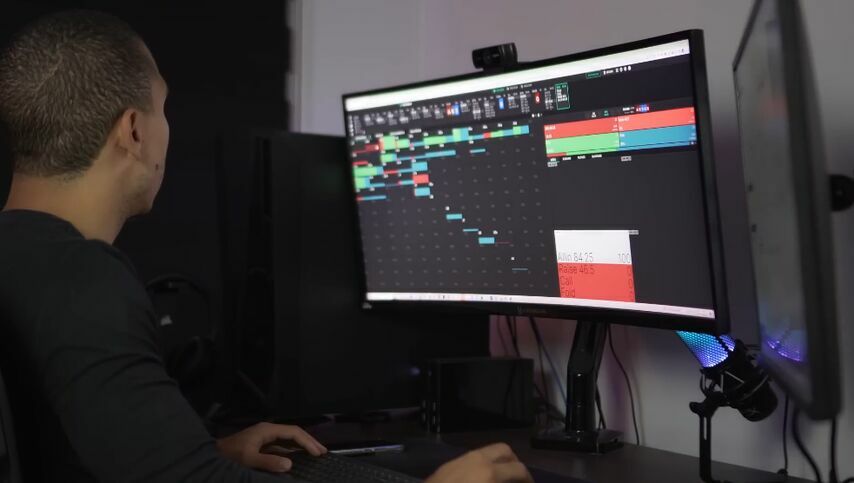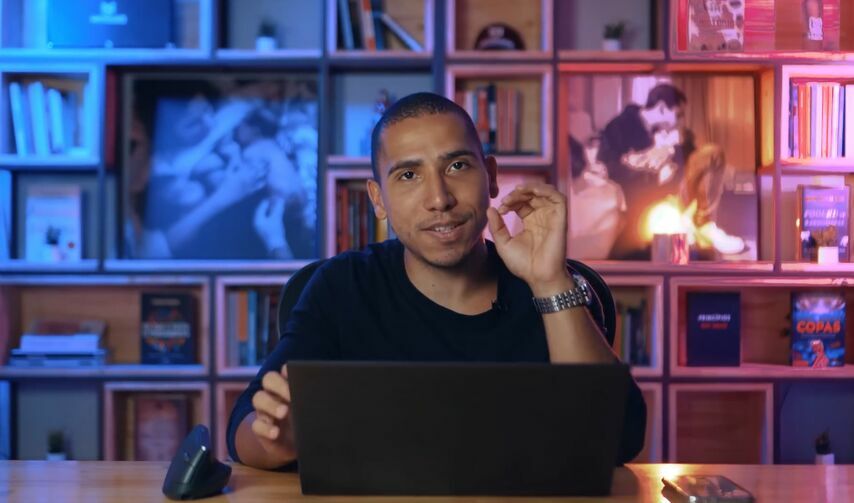– Hello, Saulo. Guests have repeatedly advised us to invite you, but I’m ashamed to admit that until recently I had never heard of you at all. I watched a few of your videos and realized how useful the content you make is. Tell us how your career began.
– I started playing professionally in 2016, when I was studying to become a programmer in college. It was a very prestigious university in Brazil, ranked in the top 100 in the world, and there was a bright future ahead. However, my soul was not in the mood for programming at all. But in poker, I immediately started to succeed, and I happily switched to a new activity. I started at NL5 and in two years reached NL200 with shots at NL500. I didn’t rule out returning to college if things didn’t work out in poker. Fortunately, I managed to avoid this; I’ve been playing professionally for seven years now.
– How did you even learn about poker, back in childhood?
– No, as a child I really loved board games and strategies, but I had never even heard of poker. I started in 2013 when I was 19 years old. A friend was playing with his girlfriend and one day asked me to join them. I immediately became obsessed with the game. I explained the rules to all my friends, and we played for 7-8 hours every day at my house. I remember with nostalgia those times when I read everything and learned something new every day.
– Did you start winning a lot right away?
– With friends, we played very cheaply; in a session, you could lose or win a couple of dollars. And I was playing incredibly tight back then, so I almost always ended up around zero.
– How did you work on your game when you started playing poker seriously?
– Then there was only one site for me – Run it Once. I sat on their forum all day long and watched free videos. Then I managed to get a paid subscription. They had a promotion, they gave points for activity on the forum and the best users were given a subscription every month. I was always among the leaders and could watch videos of the strongest coaches for free.
– Over time, did you start creating content for them yourself?
– Yes, in March 2019, that is, three years after the start of my career. I still consider this one of my most significant achievements. I grew up watching this site, so I was extremely honored when I was asked to record videos for it.
– Can you formulate what are your main differences from most coaches?
– I think I’m great at combining theory and an exploitative approach to the game. There are very few coaches who teach this hybrid style. Right now most are focused solely on GTO because the community as a whole is obsessed with theory. Only a few preach pure exploitation, and they have a very polarizing reputation. I also love theory, but I have been studying the trends of the field for many years and have learned to combine both approaches in my studies.
– Tell us a little about the trends in the field. What should you pay attention to first?
– The most obvious thing is to compare the GTO and the actual course play. We find differences and build a strategy to take advantage of these moments. At the beginning of my career, I carried out analysis in the most popular trackers, until I learned about Hand2Note. This was a real discovery. An ideal tool for working with huge databases of several million hands and analyzing field trends. I learned about this software at the end of 2017 and still use it. It may sound complicated, but in reality, it is a very simple program, and it amazes me that so few players use it. When I saw how far the game of the field was from GTO, I immediately realized that this is where we should look for the secret of poker success. It is clear that I did not immediately come to this hybrid approach. At the beginning of my career, like everyone else, I played pure exploit, and then I 100% fell into the GTO religion.

– Can you explain with a specific example? Let's say you see that the field is overfolding on a check-raise flop. What to do next? Do you study the flop structures where this happens most often, sizings, positions?
– There are no restrictions here, it all depends on your curiosity and how deeply you want to dive into it all. We start with the opponent’s sizing, then we analyze the sizing of our raise and look at the opponent’s fold frequency for such a sizing. We compare the obtained conclusions with the solver’s performance in such sizings and note the difference. If this is not enough, you can further work with specific flop structures. Naturally, beginners do not need such a deep dive. I recommend starting with general concepts, such as how the field as a whole reacts to river bets. There always comes a point in teaching when detailed analysis of specific situations no longer brings much benefit. Understanding general trends is much more useful. The simplest example is that people bluff much less often than solvers, especially in large pots. Of course, no one bothers you to study specific examples, when you understand the general trends, but usually, the results are not worth the effort. The most important thing is to understand how people deviate from the solver in different situations.
The main problem with the exploit is that it is very difficult to play correctly in the long run. Sooner or later, your opponents will understand that you are exploiting them, they will begin to adjust, and you will have to make your own adjustments. But in such a game of mutual adjustments, only a few are strong; most players begin to make mistakes.
All top players are strong in theory, but if necessary they know how to deviate towards exploitation. When you choose a mixed strategy, it makes life very difficult for your opponents, since they cannot immediately understand that you have switched to an exploit. And it’s quite easy for you to do this, provided that you understand the essence of the mix strategy. Therefore, you can quite easily deviate towards aggression or, on the contrary, passive, depending on the actions of your opponents.
– Surely it is important on which street is it most profitable for us to mix the strategy? It's one thing preflop, and quite another thing on the river. On later streets, it is more difficult for the opponent to gain distance in order to assess how balanced we are.
– It's like that. The exploit works best on the river, quite well on the turn, and much worse on the flop because our strategy becomes more clear to our opponents. I used to often use exploits on the flop, and even created a strategy for my students. At first, it worked great, but the field quickly adjusted and we switched to late street exploits for exactly the reasons you stated. We focus on river play and rare turn situations, such as 4-bet pots or delayed continuation bets in 3-bet pots. On the flop, I favor a balanced approach, this not only makes my strategy unreadable but also allows me to reach later streets with a strong range, which allows me to better control my natural frequencies.
– Is the field trend some kind of general characteristic or more specific?
– Some trends are typical for any room and limits, and some will be different. By trends I mean deviations of the field from theory. Let me give you a counterintuitive example: over bluffing on the river. You will be considered crazy if you say that at the micro-stakes, most regulars and amateurs alike bluff on the river. When I started, I was also taught that fish never bluff on the river. But then I started analyzing the game of the field and the first thing that caught my eye was that everyone always bluffs too often. Surprisingly, even now they hardly talk about this, as if the community is not interested in studying this issue at all. Although this is an indisputable fact. I could name several reasons, but I will give one. For a good and balanced game, you simply need randomization of actions. Without this, you will not be able to bluff correctly on the river,
There are fewer over bluffs on the river at high stakes than at micro-limits. This is another counterintuitive point. From the outside, it may seem that this is impossible since high rollers play too aggressively. But if you think about it, it's quite understandable. High-stakes players control their frequencies much better, randomize the game correctly, and design their ranges correctly. In addition, they understand that opponents at high limits are also stronger at bluff catching, so there is no point in bluffing too often.
If I had not specifically studied these field trends, I would never have even thought about such moments – almost everyone bluffs, but at high stakes, this happens less often than at micro stakes.
– Does this always happen or does it depend on the structure of the board?
– Amateurs re-bluff everywhere because they play with static ranges. They defend the big blind with the same range against both UTG and button raises. Regulars maintain balance post-flop in early positions – UTG and HJ. But on the cutoff, button, and blinds, noticeable re-bluffing is already beginning. That is, regulars have a greater dependence on the width of the preflop range.
– You have your own foundation, which already has more than 200 people. How did it start?
– I took my first students in 2019, there were 12 people in that class. Two of them played NL100 at the end of the course. My friend, who still remains my partner, came up with the idea to offer them backing for higher limits. After that, we began to offer cooperation to all graduates, almost no one refused, and after two months we already had 10 people playing with us. Then we began to offer backing not only to our own students, but also to other players who seemed to us suitable candidates. At the end of 2019, our group had 20 people. I'm proud to say that we have completely changed the cash games in Brazil. Five years ago NL200 was played by 3-4 players, including me and a partner, but now 30 people from us alone conquer this limit.
– Do you only hire Brazilians?
– Approximately 80%, the remaining 20% are players from England, Ireland, Australia, France, Austria and other countries.
– Does everything that you told us about field trends apply exclusively to cash games? Don't you play tournaments at all?
– Yes, I conduct research exclusively for online cash. Tournaments have never interested me. I don't know why. Perhaps because at the beginning of my career, I really loved watching shows with Ivey and Dwan.

– What difficulties did you encounter when you started managing a large fund?
– I do not even know where to start. The biggest challenge was probably the need to constantly communicate with people, especially my partner. I've always been a loner, doing everything on my own. Running a business together turned out to be very difficult. It has a lot in common with family relationships, and I have something to compare with, since my wife and I are raising two children. For a business (and this is practically your child) to be successful, you need to constantly find a common language with a person with whom you may have little in common. And at the start of our project, we had disagreements on all issues. The ability to find compromise is one of the main lessons I have learned in recent years.
– Do you still continue to work with students?
– I only train with the strongest, who play NL500 and above; the rest work with other coaches, of whom we already have seven on the team. I have always been able to easily train others. It started in regular school. When classmates didn’t understand something, they came to me for explanations, not to the teacher. As a teenager, I even participated in a social project and taught English and mathematics to everyone for free on weekends.
– What aspects of theory do you focus on most when working on a game?
– Looking for the maximum edge. Now this is what my philosophy of learning and finding new strategies is based on. We got to this point in one of the lessons with our strongest student, who plays limits up to NL5k. At some point, it became obvious to us that at the highest level, the maximum edge is obtained by counterintuitive actions. That is, our goal is to deliberately deviate from the solver in order to put our opponents in situations for which they are not ready. For example, we know that on a certain GTO flop we should bet 75% of the pot, but we specifically bet 150%. Against an ideal opponent, such a play will lower our expectations, but against a real opponent, we hope to gain an additional advantage because we have studied the game in such sizes, and he, most likely, has not. Now my work on the game is to find situations like this, when deviation from the theory does not threaten me with large losses, but the potential benefit against an unprepared opponent can be enormous. But this approach is only suitable for those players who are already playing at the highest level. I don’t recommend such experiments for those who are moving up the limits.
– Last question. Your native language is Portuguese. Where did you learn English so well?
– In addition to regular school, I went to English school once a week. But I won’t say that it was very useful. What really helped me was 10 seasons of Friends. I rewatched it six times. At the age of 18, I already spoke fluently and received compliments from native speakers.













